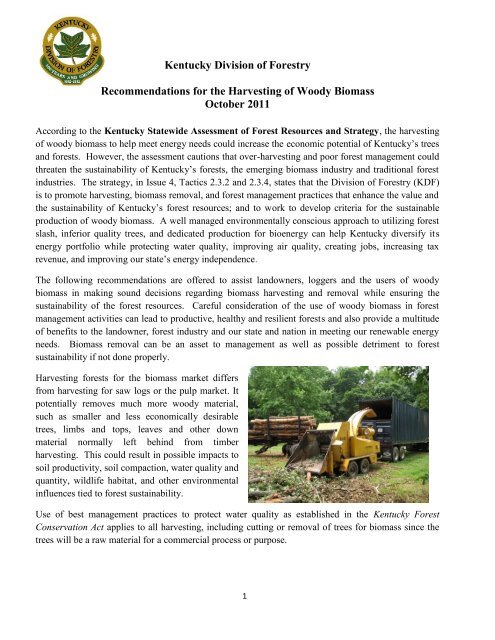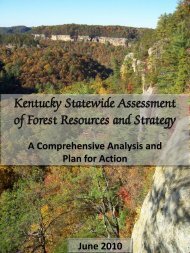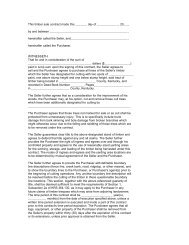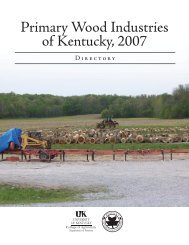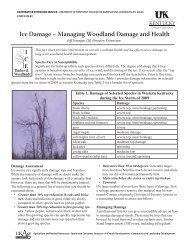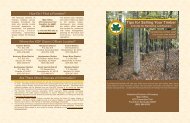Recommendations for the Harvesting of Woody Biomass - Kentucky ...
Recommendations for the Harvesting of Woody Biomass - Kentucky ...
Recommendations for the Harvesting of Woody Biomass - Kentucky ...
Create successful ePaper yourself
Turn your PDF publications into a flip-book with our unique Google optimized e-Paper software.
<strong>Kentucky</strong> Division <strong>of</strong> Forestry<br />
<strong>Recommendations</strong> <strong>for</strong> <strong>the</strong> <strong>Harvesting</strong> <strong>of</strong> <strong>Woody</strong> <strong>Biomass</strong><br />
October 2011<br />
According to <strong>the</strong> <strong>Kentucky</strong> Statewide Assessment <strong>of</strong> Forest Resources and Strategy, <strong>the</strong> harvesting<br />
<strong>of</strong> woody biomass to help meet energy needs could increase <strong>the</strong> economic potential <strong>of</strong> <strong>Kentucky</strong>’s trees<br />
and <strong>for</strong>ests. However, <strong>the</strong> assessment cautions that over-harvesting and poor <strong>for</strong>est management could<br />
threaten <strong>the</strong> sustainability <strong>of</strong> <strong>Kentucky</strong>’s <strong>for</strong>ests, <strong>the</strong> emerging biomass industry and traditional <strong>for</strong>est<br />
industries. The strategy, in Issue 4, Tactics 2.3.2 and 2.3.4, states that <strong>the</strong> Division <strong>of</strong> Forestry (KDF)<br />
is to promote harvesting, biomass removal, and <strong>for</strong>est management practices that enhance <strong>the</strong> value and<br />
<strong>the</strong> sustainability <strong>of</strong> <strong>Kentucky</strong>’s <strong>for</strong>est resources; and to work to develop criteria <strong>for</strong> <strong>the</strong> sustainable<br />
production <strong>of</strong> woody biomass. A well managed environmentally conscious approach to utilizing <strong>for</strong>est<br />
slash, inferior quality trees, and dedicated production <strong>for</strong> bioenergy can help <strong>Kentucky</strong> diversify its<br />
energy portfolio while protecting water quality, improving air quality, creating jobs, increasing tax<br />
revenue, and improving our state’s energy independence.<br />
The following recommendations are <strong>of</strong>fered to assist landowners, loggers and <strong>the</strong> users <strong>of</strong> woody<br />
biomass in making sound decisions regarding biomass harvesting and removal while ensuring <strong>the</strong><br />
sustainability <strong>of</strong> <strong>the</strong> <strong>for</strong>est resources. Careful consideration <strong>of</strong> <strong>the</strong> use <strong>of</strong> woody biomass in <strong>for</strong>est<br />
management activities can lead to productive, healthy and resilient <strong>for</strong>ests and also provide a multitude<br />
<strong>of</strong> benefits to <strong>the</strong> landowner, <strong>for</strong>est industry and our state and nation in meeting our renewable energy<br />
needs. <strong>Biomass</strong> removal can be an asset to management as well as possible detriment to <strong>for</strong>est<br />
sustainability if not done properly.<br />
<strong>Harvesting</strong> <strong>for</strong>ests <strong>for</strong> <strong>the</strong> biomass market differs<br />
from harvesting <strong>for</strong> saw logs or <strong>the</strong> pulp market. It<br />
potentially removes much more woody material,<br />
such as smaller and less economically desirable<br />
trees, limbs and tops, leaves and o<strong>the</strong>r down<br />
material normally left behind from timber<br />
harvesting. This could result in possible impacts to<br />
soil productivity, soil compaction, water quality and<br />
quantity, wildlife habitat, and o<strong>the</strong>r environmental<br />
influences tied to <strong>for</strong>est sustainability.<br />
Use <strong>of</strong> best management practices to protect water quality as established in <strong>the</strong> <strong>Kentucky</strong> Forest<br />
Conservation Act applies to all harvesting, including cutting or removal <strong>of</strong> trees <strong>for</strong> biomass since <strong>the</strong><br />
trees will be a raw material <strong>for</strong> a commercial process or purpose.<br />
1
The Division <strong>of</strong> Forestry encourages <strong>for</strong>est landowners to have a <strong>for</strong>est management plan<br />
prepared by a qualified natural resource pr<strong>of</strong>essional (a <strong>for</strong>estry graduate or a person who by<br />
training and experience understands silviculture and can make <strong>for</strong>est management<br />
recommendations) in place be<strong>for</strong>e beginning any timber harvest.<br />
Preharvest planning should include a written contract between <strong>the</strong> landowner and <strong>the</strong> logger to<br />
include all expectations and requirements <strong>of</strong> both parties.<br />
<strong>Recommendations</strong> <strong>for</strong> <strong>Biomass</strong> Harvests<br />
o<br />
o<br />
o<br />
o<br />
Forest landowners should consider <strong>the</strong> highest and best use <strong>of</strong> <strong>the</strong> trees to be harvested to<br />
maximize <strong>the</strong> value <strong>of</strong> <strong>the</strong> wood and to promote <strong>the</strong> sustainability <strong>of</strong> <strong>the</strong>ir <strong>for</strong>est while<br />
expanding <strong>the</strong> utilization <strong>of</strong> woody biomass.<br />
All commercial harvesting must comply with<br />
<strong>Kentucky</strong>’s harvesting requirements and best<br />
management practices (BMPs) in accordance with<br />
<strong>the</strong> <strong>Kentucky</strong> Forest Conservation Act and <strong>the</strong><br />
silvicultural BMPs in <strong>the</strong> <strong>Kentucky</strong> Agriculture<br />
Water Quality Act.<br />
<strong>Woody</strong> biomass harvesting operations should be<br />
completed in conjunction with a traditional harvest<br />
or o<strong>the</strong>r management activity when possible to<br />
minimize soil compaction and o<strong>the</strong>r detrimental<br />
effects on site productivity, water quality and<br />
quantity, wildlife habitat, and o<strong>the</strong>r environmental<br />
influences tied to <strong>for</strong>est sustainability.<br />
Hardwood <strong>for</strong>ests regenerate through stump sprouts,<br />
seedlings (naturally occurring and planted) and<br />
samplings; <strong>the</strong>re<strong>for</strong>e, re-entry to harvest biomass<br />
after <strong>the</strong> site has been retired from a traditional<br />
harvest should occur within five years <strong>of</strong> <strong>the</strong><br />
traditional harvest. <strong>Biomass</strong> harvesting should be<br />
avoided five years after <strong>the</strong> traditional harvest until <strong>the</strong> regenerated trees have grown large<br />
enough <strong>for</strong> a normal harvest rotation <strong>for</strong> typical round wood products. The removal <strong>of</strong> stumps,<br />
roots, and litter from <strong>the</strong> <strong>for</strong>est floor is discouraged in order to maintain site productivity <strong>for</strong> <strong>the</strong><br />
regeneration and growth <strong>of</strong> a new <strong>for</strong>est.<br />
o<br />
Timing harvest operations to avoid logging in wet soil<br />
conditions or concentrated equipment travel patterns<br />
can prevent unnecessary impacts, such as compaction<br />
and rutting, which degrade site productivity.<br />
2
o<br />
o<br />
o<br />
o<br />
o<br />
o<br />
o<br />
The removal <strong>of</strong> woody biomass has <strong>the</strong> potential to increase <strong>the</strong> surface and subsurface flow <strong>of</strong><br />
water resulting in increased soil movement, erosion, and stream flow.<br />
<strong>Biomass</strong> harvesting should avoid or minimize biomass removal on steep slopes with highly<br />
erodible soils and o<strong>the</strong>r sensitive sites, such as habitats <strong>for</strong> threatened and endangered species,<br />
special consideration areas, nature preserves, prairie types, and wetlands.<br />
To ensure enough logging<br />
slash is left scattered across<br />
<strong>the</strong> area to maintain site<br />
productivity and wildlife<br />
habitat diversity, KDF and<br />
<strong>the</strong> <strong>Kentucky</strong> Department<br />
<strong>for</strong> Fish and Wildlife<br />
Resources recommend<br />
leaving 15-30% <strong>of</strong> logging<br />
residue (tops and log butts)<br />
disbursed across <strong>the</strong> harvest<br />
area.<br />
<strong>Woody</strong> biomass harvests<br />
can both positively affect<br />
some wildlife populations<br />
while negatively affecting o<strong>the</strong>rs. Retaining key structural features such as snags, den trees, and<br />
large coarse woody debris is critical to wildlife. Consult a qualified natural resources<br />
pr<strong>of</strong>essional regarding this issue.<br />
<strong>Harvesting</strong> activities that destroy <strong>the</strong> habitats <strong>of</strong> federally threatened or endangered animals are<br />
prohibited under <strong>the</strong> Endangered Species Act <strong>of</strong> 1973 and can result in civil or criminal<br />
penalties. Contact <strong>the</strong> U.S. Fish and Wildlife Service <strong>for</strong> more in<strong>for</strong>mation.<br />
When considering a short rotation woody crop (SRWC), select species that are native t o<br />
<strong>Kentucky</strong>, appropriate <strong>for</strong> <strong>the</strong> site where <strong>the</strong> plantation will be established, and have available<br />
markets. Some SRWCs are invasive and highly aggressive and can negatively impact <strong>the</strong><br />
environment and <strong>Kentucky</strong>’s native <strong>for</strong>ests. Consult a qualified resource pr<strong>of</strong>essional prior to<br />
establishing a biomass plantation.<br />
Soil disturbance from harvesting creates conditions favorable to <strong>the</strong> establishment <strong>of</strong> non-native<br />
plants and aggressive native plants. Prescriptions <strong>for</strong> treatment <strong>of</strong> specific invasive plants can<br />
be found at several locations on <strong>the</strong> internet including<br />
http://www.invasivespeciesinfo.gov/plants/controlmech.shtml.<br />
3
DEFINITIONS<br />
o<br />
o<br />
o<br />
o<br />
o<br />
o<br />
o<br />
o<br />
o<br />
o<br />
<strong>Woody</strong> biomass: Any woody organic material that is available on a renewable or recurring basis<br />
including trees, wood, and wood residues. [See KRS. 152.715 (4)]<br />
Sustainable Forest Management: The stewardship and use <strong>of</strong> <strong>for</strong>ests to maintain <strong>the</strong>ir health,<br />
productivity, diversity, and overall integrity, in <strong>the</strong> long run, in <strong>the</strong> context <strong>of</strong> human activity<br />
and use.<br />
Renewable Energy: Renewable energy sources are constantly available, or can be replenished in<br />
a short period <strong>of</strong> time. The most common sources include solar, wind, geo<strong>the</strong>rmal, hydropower,<br />
and biomass (e.g. wood, solid waste, landfill gas, ethanol, and biodiesel).<br />
Exotic or nonnative plants: A plant or species introduced from ano<strong>the</strong>r country or geographic<br />
region outside its natural range.<br />
Biodiversity (biological diversity): The variability among living organisms from all sources.<br />
Litter: The natural organic material on <strong>the</strong> <strong>for</strong>est floor.<br />
Slash: Residual material from <strong>the</strong> harvesting operation.<br />
Short rotation woody crops: <strong>Woody</strong> biomass grown in a short rotation (typically 2-5 yrs) <strong>for</strong> <strong>the</strong><br />
purposes <strong>of</strong> producing fiber or alternative energy.<br />
Genetically modified organisms are generally created by gene implantation vs. genetically<br />
improved (select genotypes or hybrids) are not produced through gene implantation but are<br />
superior families or hybrids produced through open-pollination, mass controlled pollination, or<br />
vegetative means (i.e., clonal/varietal).<br />
Regeneration: Renewing tree cover by establishing young trees naturally or artificially.<br />
4
RESOURCES<br />
Greis, John G.; Development <strong>of</strong> Guidelines <strong>for</strong> <strong>Woody</strong> <strong>Biomass</strong> <strong>Harvesting</strong> – Some Considerations; a<br />
White Paper Prepared by: USDA Forest Service State and Private Forestry Sou<strong>the</strong>rn Region April 29,<br />
2009<br />
Evans, Alexander M., and Robert T. Pershel; 2009; An Assessment <strong>of</strong> <strong>Biomass</strong> <strong>Harvesting</strong> Guidelines.<br />
Forest Guild, Santa Fe, NM<br />
<strong>Woody</strong> <strong>Biomass</strong> <strong>Harvesting</strong> Guidelines; – A white paper prepared by <strong>the</strong> Services, Utilization and<br />
Marketing Task Force and approved by Sou<strong>the</strong>rn Group <strong>of</strong> State Foresters 2009<br />
<strong>Kentucky</strong> Statewide Assessment <strong>of</strong> Forest Resources and Strategy; <strong>Kentucky</strong> Division <strong>of</strong> Forestry, June<br />
2010<br />
Dictionary <strong>of</strong> Forestry, Society <strong>of</strong> American Foresters, 1998<br />
National Report on Sustainable Forests—2010: United States Department <strong>of</strong> Agriculture, Forest<br />
Service; FS-979; June 2011<br />
Contributing Agencies: <strong>Kentucky</strong> Division <strong>of</strong> Water, <strong>Kentucky</strong> Department <strong>of</strong> Fish and Wildlife<br />
Resources, <strong>Kentucky</strong> Department <strong>of</strong> Conservation, <strong>Kentucky</strong> Nature Preserves Commission, University<br />
<strong>of</strong> <strong>Kentucky</strong> Department <strong>of</strong> Forestry, U.S. Forest Service, U.S. Fish and Wildlife Service<br />
5


